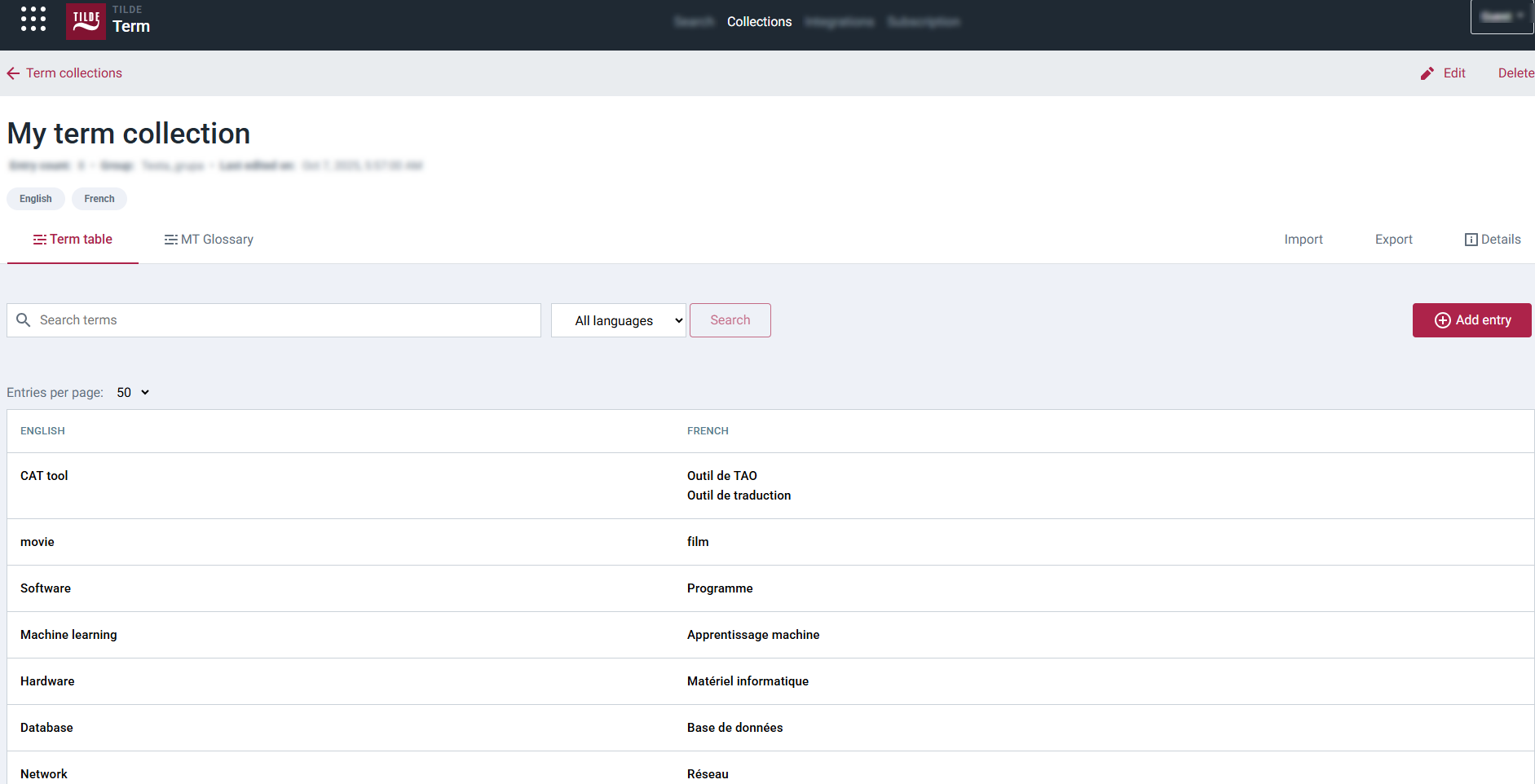Getting started with Tilde Term
Tilde Term platform centralizes your terms and machine translation glossaries, allowing you to look up your private terms and EuroTermBank entries.
Why use the Tilde Term platform?
- Consistency: Ensure uniform terminology across all content and languages within your organization.
- Quality: Minimize errors and ambiguity in human and machine translations for clearer communication.
- Efficiency: Simplify terminology management, sharing, and usage for translators, writers, and content creators, saving time.
- Improved MT: Enhance machine translation accuracy and relevance by providing glossaries (for selected languages).
Guides
Explore our guides to learn how to use different parts of the Tilde Term platform.
- Create a new collection
- Term table
- MT Glossary
- Import collection data
- Export collection data
- Delete collection
- Search terms
- For developers
Quick start guide
- Create a new terminology collection.
- Add your terms and their details.
- Import your existing terms from files (
.xlsx,.csv,.tbx). - Manage your terms by changing their status (Approved / Draft).
- Discuss the terms with your colleagues by adding comments.
- Manage your MT glossary used in Tilde MT machine translation.

For developers
Integrate the terminology search widget into your website: Tilde Term Search Widget
Frequently asked questions
Find answers to common questions about setting up and using the Tilde Term platform.
Getting Started & Collections
How do I create a new terminology collection?
What information do I need to provide when creating a collection?
You'll typically need to provide a title for your collection, specify the default language and optionally specify the domain or subject area it covers.
Can I organize my terminology into multiple collections?
Yes, you can create multiple collections to organize your terminology by project, domain, or any other criteria that suits your workflow.
Can I share my collections with others?
All collections are shared between users of the same user group or organization.
How do I delete a terminology collection?
Refer to: Delete collection
Adding & Managing Terms
How can I add terms to my collection?
You can add terms manually or import them from various file formats. See: Create collection and add terms
What file formats are supported for importing terms?
You can import terms from .xlsx (Microsoft Excel), .tbx (TermBase eXchange), .csv (Comma-separated values), and .tsv (Tab-separated values) files.
How should I format my import file?
Your import file should contain at least source and target terms. You can also include additional metadata. For specific formatting guidance, see: Create collection and add terms and the tip about exporting a sample collection.
Can I edit existing terms?
Yes, you can view and edit terms directly in the Term table or MT Glossary view.
What does the "Approved" / "Draft" status mean for a term?
"Approved" indicates a finalized term ready for use, while "Draft" signifies a preliminary or under-review term.
How do I delete a term?
You can delete individual terms or entire term entries. See: Managing terms using the term table
Can I add definitions, examples, or other metadata to my terms?
Yes, you can add various details to your terms, including definitions, context examples, usage notes, and more. See: Adding a new term entry.
How can I add images or videos to my terms?
You can link to publicly hosted images and videos to provide visual context for your terms. See: Adding media links to a term entry
Collaboration & Discussion
Can I discuss terms with my colleagues within the platform?
Yes, you can add comments to term entries to discuss them with your team. See: Using comments discussion
How do I see if a term has any comments?
A comment icon (💬) with a count will appear at the end of rows containing discussion comments in the Term table view.
Machine Translation Glossaries
What is an MT glossary?
An MT glossary (machine translation glossary) is a specialized collection of your preferred terms and their translations used to improve the accuracy and consistency of machine translation.
How do I create an MT glossary?
You can create MT glossaries from various parts of the platform. See: Machine translation glossaries
How do I add terms to an MT glossary?
You can add term pairs (source and target language terms) directly in the MT Glossary view.
How do I use an MT glossary with machine translation?
You can set glossaries as default for all MT usage or assign specific glossaries to individual projects or integrations.
How do I manage the settings for terms in an MT glossary (e.g., non-translatable, case-sensitive)?
You can configure various attributes for terms in the MT Glossary view, such as whether they should be translated, if they are case-sensitive, and if inflected forms should be considered. See: Machine translation glossaries
How do I export my terminology collections?
You can export your collections in .xlsx, .tbx, and .csv formats. See: Export collection
How do I export my MT glossaries?
MT glossaries can be exported in .json format. See: Export collection
How can I search for terms within my collections and EuroTermBank?
You can use the search functionality to find terms across your private collections and EuroTermBank. See: Search terms
What are the different search views?
You can view search results in a concise Simple view or a more comprehensive Detailed view. See: Search terms